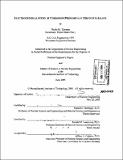| dc.contributor.advisor | Ronald G. Ballinger. | en_US |
| dc.contributor.author | Treeman, Nicole M | en_US |
| dc.contributor.other | Massachusetts Institute of Technology. Dept. of Nuclear Engineering. | en_US |
| dc.date.accessioned | 2006-11-07T12:10:46Z | |
| dc.date.available | 2006-11-07T12:10:46Z | |
| dc.date.copyright | 2005 | en_US |
| dc.date.issued | 2005 | en_US |
| dc.identifier.uri | http://hdl.handle.net/1721.1/34442 | |
| dc.description | Thesis (Nucl. E. and S.M.)--Massachusetts Institute of Technology, Dept. of Nuclear Engineering, 2005. | en_US |
| dc.description | Includes bibliographical references. | en_US |
| dc.description.abstract | Shadow corrosion of zirconium alloy fuel cladding in BWR environments, the phenomenon in which accelerated corrosion is experienced when the cladding surface is in close proximity to other metals, has become a potentially life-limiting issue for BWR fuel. Recent results from experimentation at MIT, Halden, and Studvik suggest that a galvanic coupling drives the phenomenon between the cladding and the adjacent material. However, the actual processes involved are not understood. One key parameter that would help in the understanding of the phenomenon would be a measurement of the actual corrosion current between fuel cladding and adjacent materials in the actual in-reactor environment. The limitations placed on the bum-up of uranium oxide fuel correlates to the amount of corrosion seen through a directly measurable oxide thickness on the waterside of the zirconium alloy cladding. This oxide corrosion product directly correlates to distance from structural components, leading to the effect commonly referred to as shadow corrosion. In recent experiments, Studvik determined that there are large ECP differences associated with Inconel and zirconium alloys that correlate to increased galvanic current density when the materials are coupled. | en_US |
| dc.description.abstract | (cont.) In this thesis research, four electrode pairs were used to measure galvanic current densities in the irradiation environment: Pt-Pt, Zircaloy 2 (Zr-2)-Pt, Inconel (X-750)-Pt, and Zr-2-X-750. To determine the changes in the coolant water conductivity due to the presence of radiolysis products, electrochemical potential measurements of Pt-Pt coupled electrodes were analyzed. Finally, attempts to characterize the observed oxide behavior using measurements from Electrochemical Impedance Spectroscopy (EIS), also known as Alternating Current Impedance, were conducted. Through the measurements taken, analysis of the mechanisms potentially causing the shadow corrosion phenomenon was conducted. The results of the observations included: -- Measurement of increased conductivity of coolant water correlating to increases in reactor power. -- Measurement of increased galvanic current measurements correlating to increases in reactor power. | en_US |
| dc.description.statementofresponsibility | by Nicole M. Treeman. | en_US |
| dc.format.extent | 135 p. | en_US |
| dc.format.extent | 15688255 bytes | |
| dc.format.extent | 15693974 bytes | |
| dc.format.mimetype | application/pdf | |
| dc.format.mimetype | application/pdf | |
| dc.language.iso | eng | en_US |
| dc.publisher | Massachusetts Institute of Technology | en_US |
| dc.rights | M.I.T. theses are protected by copyright. They may be viewed from this source for any purpose, but reproduction or distribution in any format is prohibited without written permission. See provided URL for inquiries about permission. | en_US |
| dc.rights.uri | http://dspace.mit.edu/handle/1721.1/7582 | |
| dc.subject | Nuclear Engineering. | en_US |
| dc.subject.lcsh | Electrochemistry | en_US |
| dc.subject.lcsh | Alloys Analysis | en_US |
| dc.subject.lcsh | Zirconium | en_US |
| dc.title | Electrochemical study of corrosion phenomena in zirconium alloys | en_US |
| dc.type | Thesis | en_US |
| dc.description.degree | Nucl.E.and S.M. | en_US |
| dc.contributor.department | Massachusetts Institute of Technology. Department of Nuclear Engineering | en_US |
| dc.contributor.department | Massachusetts Institute of Technology. Department of Nuclear Science and Engineering | |
| dc.identifier.oclc | 70690666 | en_US |
